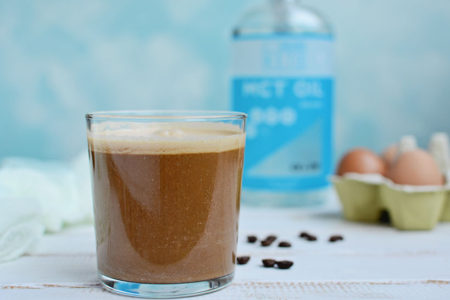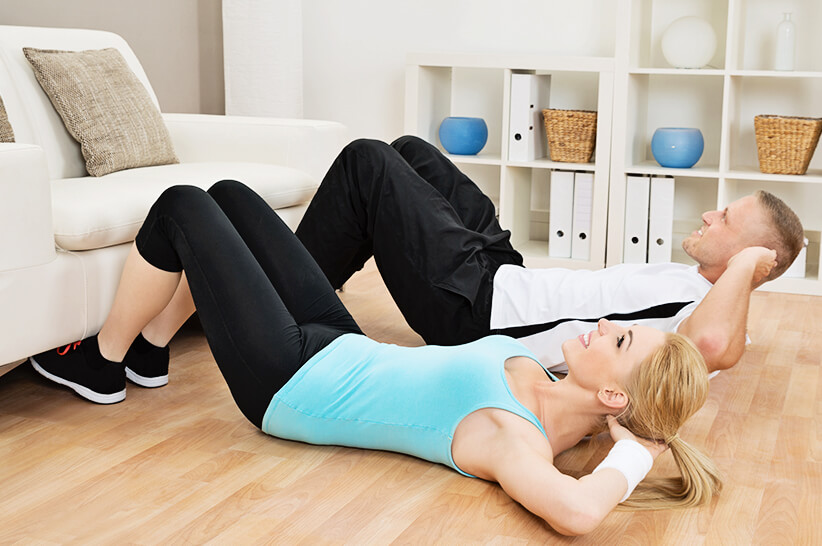It’s that time of the year again when gyms are crowded with folks working hard on getting that beach body. If you’d rather avoid a crammed gym or spend your money elsewhere, here are some at-home workouts that can be just as effective at weight loss and improve your fitness when done correctly and consistently.
When it comes to using exercise for weight loss, variety is the key. The best at-home workouts for weight loss are always those that include a combination of endurance, strength, high-intensity intervals, balance, and flexibility training. Resistance training helps build muscle and boost metabolic rate, while cardio will boost your well-being and contribute to total calories burned. Interval training will help with both, cardio and strength. Balance and flexibility will help reduce your risk of injury or falls.
Below, you’ll see what workouts are best and why. We’ll also give you 15 workouts to boost your body’s fat-burning potential from the comfort of your own home.
Types of At-Home Workouts
Going to the gym has many advantages. For example, having a gym membership can work as a motivational factor. Secondly, you get access to gym equipment, personal trainers, a yoga studio, pools, saunas, child-care services, and many other amenities. Then there’s the possibility of meeting new people and spending time away from home.
But the gym isn’t really for everyone. If you can’t or don’t want to join the gym to lose weight, then at-home workouts are perfect for you, especially if you combine them with outdoor workouts. At-home workouts can include all major types of training such as:
Aerobic
Also called endurance training or cardio, aerobic activities include running, cycling, walking, hiking, and swimming. These workouts increase your breathing and heart rate, keeping your lungs and circulatory system strong and healthy. And, of course, they boost your endurance. In addition, they help to burn or metabolize a significant amount of calories.
Strength building
Workouts like weight-lifting, squats, planks, and rock climbing are called strength building or resistance training. They make your muscles stronger by exerting them through resistance either from a heavy object like dumbbells or the weight of your own body.
Essentially, you produce small micro tears in your muscles which then get healed and rebuilt with additional muscle fibers thereby improving strength and hypertrophy.
Balance
Standing on one foot, yoga and Tai Chi are examples of balance exercises. These workouts help maintain good balance to reduce your risk of falls and straining. They’re best practiced during warm-ups.
Flexibility
Yoga, Pilates, calisthenics and any type of workout that involves stretching your muscles enhances flexibility. Being flexible is important for your overall fitness since it increases your body’s freedom of movement. And with greater freedom of movement, you’ll see that other activities become much easier.

If you have weights, a treadmill, or a Pilates ball, then all the better. But many of the workouts you’ll see here can be done hands-free and will require nothing but your time and a good pair of good sneakers.
The Benefits of at Home Workouts
Working out, wherever you chose to do it, comes with a wide range of benefits. But where at-home workouts are concerned, here are the major benefits:
Budget-friendly
Gym memberships can cost anywhere between $10 and $100 a month. You’ll also save up on expensive workout equipment, transport, snacks, and more.
Motivational
When feeling tired and unmotivated, a lot of people will come up with excuses not to hit the gym. Well, your range of excuses falls low when it comes to not setting aside a couple of minutes daily to workout in your living room.
Enjoyable
Working out on your own terms, in your own home, to tunes that you love is something to be enjoyed. Not to mention that you can make a fool out of yourself without worrying about spectators.
Minimal equipment
Relying on gym equipment to get the results you want to can feel disempowering at times. But when working out in your own home with basic equipment, if any, you’ll definitely get a sense that you own your workout routine.
Time saving
Getting ready for the gym, taking a ride to the gym, and taking the arduous track back home can prove draining on your time and energy levels. Since most of us nowadays don’t have much time to spare, at-home workouts can prove more practical.
Family-friendly
No need to arrange for a babysitter when you’re working out from your own home. Just make good use of nap times or get the kids involved in your exercise routine – exercising can make for fun family times.
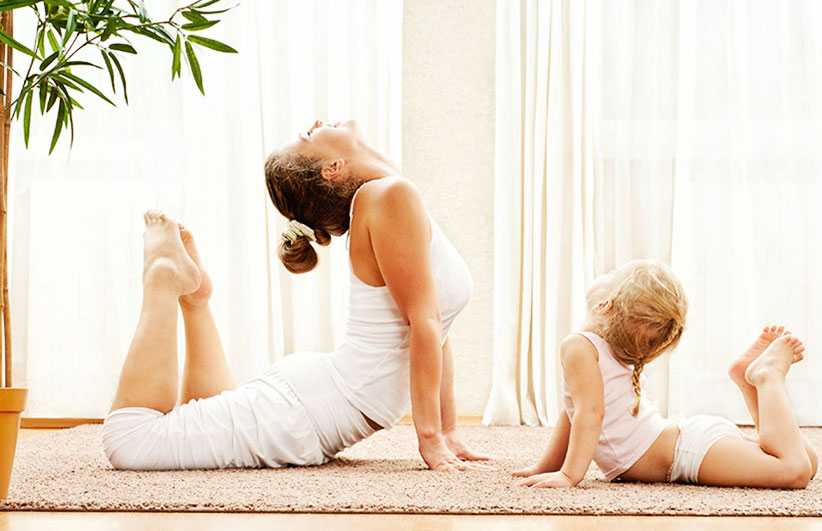
Other benefits to at-home workouts include flexible schedules, convenience, and travel-friendliness. And since sustainability and adherence are scientifically proven to be important factors for weight-loss success 1, at-home workouts, which are more sustainable than gyms, are more likely to lead to long-term success.
How Effective Are at Home Workouts for Weight Loss?
At-home workouts are as effective as you make them. If you’re inconsistent or lax with your workouts, they obviously won’t lead to weight loss. But a good workout routine, on the other hand, can definitely make a difference in how many pounds you’re shedding.
The National Health Service and American Heart Association recommend at least 150 minutes of aerobic activity weekly for good health 2, 3. However, studies found that you would need to spend more than the bare minimum of time working out to make a noticeable difference in your weight loss 4. You will also need to increase the intensity of your workouts with time and you will also need to follow a low calorie diet. To understand why you cannot lose weight with exercise alone, you need to be familiar with how weight loss and weight gain work.
First, the old adage that you need to burn more calories than you’re currently taking is at the core of all weight lost. So, the calories in, calories out rule applies whichever diet you’re on. Secondly, studies show that your body spends 60-70% of its daily calories maintaining basic functions, i.e. resting energy expenditure (REE), and less than 10% on digesting food 5. So, you can expect that your workouts will burn a maximum of 30% of calories you eat.
Furthermore, your body adapts to weight loss by lowering its REE, which makes weight loss difficult after a period of time and why people experience keto plateaus 6. However, the ketogenic diet has proved to be revolutionary in this regard since it does not cause a drop in REE. But your REE also depends on your muscle mass, which exercise, and the keto diet, help maintain. Having a higher REE while on a ketogenic diet will improve the rate and efficiency of fat metabolism.
So, at-home workouts are effective as long as you’re also following a weight-loss diet and if you’re exercising intensely and for long enough (over 210 min/week or 30 minutes of exercise per day).
15 At-Home Workouts to Maximize Fat Burning
Below are examples of 15 at-home workouts in beginner, intermediate, and advanced levels that you can do to boost fat burning. Do a combo of 5 workouts daily to meet the 150-minutes a week mark (i think most recommendations are now for 30 minutes a day 7 days per week, or, preferably more), and you’ll be burning enough calories to see a difference in your weight loss.
At Home Workouts for Beginners
1. Bodyweight lunges
Lunges are probably the best entry-level workouts because they’re simple and work multiple muscles at once. Lunges work your thighs, calves, and glutes but also engage your core. If you’re a beginner, start without any weights and introduce them when you feel ready.

| Equipment | No equipments or dumbells |
| Frequency | 2-3 times per week |
| Duration | 12 sets (5-10 minutes) |
| How to do it | To do lunges, stand with your back straight and chin parallel to the floor. Step forward, supporting your upper body on both feet. Make sure to lower your hips and that your knees are at a 90-degree angle. As you push yourself back, keep your weight in your heels. Keep your spine upright, making sure not to lean forward. |
| Tips | If you have knee pain, doing a reverse lunge may be easier. Alternatively, try taking smaller steps as you lunge. |
2. Jog in place
Jogging in place is a great cardio workout that can increase your heart rate in-between strength training. You can perform it at a slower pace when you start and increase the intensity with time. While it will definitely get your heart pumping and increase your lung capacity, it doesn’t replace the calorie-burning and muscle-enhancing benefits of running. So, do look at jogging in place as a great warm-up activity for beginners.
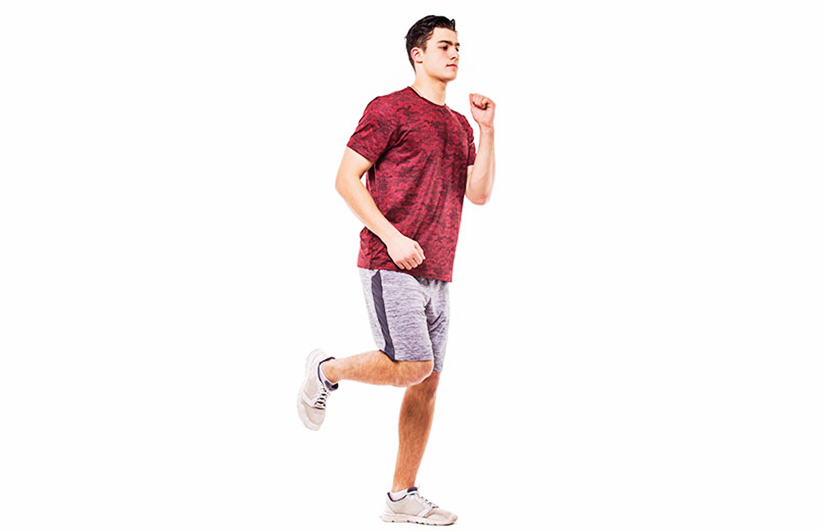
| Equipment | No equipments or dumbells |
| Frequency | 7 days a week |
| Duration | 15-30 minutes |
| How to do it | Start by walking in place for 5 minutes to warm up and follow up by stretching your thigh, calf, and hamstrings. Now, start making slow walking motions by lifting your knees at hip level interchangeably and move your hands up and down as you would while running. Slowly increase the pace of your jog until you’re jogging. Do this for long enough to increase your heart and breathing rate. |
| Tips | Alternate between intense jogging and walking in place. It can be difficult to maintain a fast pace if you’re a beginner, so do take it slowly. |
3. Squats
Squats are extremely popular weight-bearing workouts because they effectively work all major muscles in your lower body. Squatting helps shape and tone the thighs and buttocks. Squats also strengthen the core, improve balance, and improve bone density.
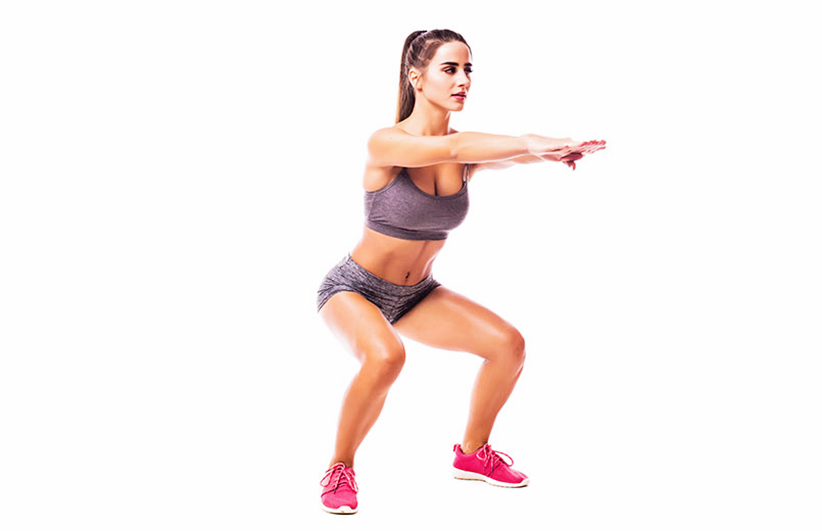
| Equipment | No equipments or dumbells |
| Frequency | 2-3 times per week |
| Duration | 2 sets, 10 reps (15 minutes) |
| How to do it | Stand with feet a bit more than shoulder-width apart and your arms straight in front of you. Move as if you’re going to sit on a chair, bending your knees and keeping your back straight. Your legs should be at a 90-degree angle and you should feel tension in your thighs and back. Lift yourself up from your heels to a standing position and repeat. |
| Tips | Advanced squatting can be done with dumbbells or other weighs, which you should hold in front of your chest. |
4. Jumping Jacks
A whole-body cardio workout that brings back childhood memories, jumping jacks are known to improve stamina, relieve stress, enhance flexibility, and stretch the muscles in your limbs, core, and hips.

| Equipment | No equipment |
| Frequency | 7 days a week |
| Duration | 1 set, 30 reps (5-10 minutes) |
| How to do it | Jump, spreading your legs apart and lifting your hands above your head. When landing on the floor, bring your feet back together and hands to your sides. Perform at the speed you feel most comfortable with. |
| Tips | To boost intensity, increase the speed and reps and sets. |
5. Planks
Another weight-bearing, static workout, planks strengthen the abdominal and back muscles. They’re one of the easiest weight-bearing workouts out there, which is great for beginners.

| Equipment | No equipment |
| Frequency | 2-3 days a week |
| Duration | 6 sets lasting 10-30 seconds |
| How to do it | Lie on solid surface on your front and with your fists clasped and your forearms on the floor while you’re supporting your lower body on your toes. Remain in this position for up to 30 seconds, rest, and repeat. |
| Tips | Do not sink into your shoulders but try to support your upper body on your forearms. Also, breath slow and steadily. |
Intermediate at Home Workout
1. Push-ups
Push-ups help build strength in almost every upper-body muscle. They work the pectorals, shoulders, triceps, wing muscles, and your abdomen. Push-ups are hard for beginners, but perfect for those looking to intensify their workout routine.

| Equipment | No equipment |
| Frequency | 3-4 days a week |
| Duration | 10-20 push-ups, 3 sets |
| How to do it | Get into a plank position, supporting your upper body on your palms. Make sure your hands are slightly more than shoulder-width apart. Your feet should be slightly apart and your toes touching the ground. Lower your body until it lightly touches the ground and lift yourself up with your hands. Rest in-between sets. If push ups are too hard, you can start with your knees on the group and do the push-ups in a modified manner. |
| Tips | To avoid hurting your neck, keep your head in a neutral position, not looking upwards or having your chin tucked in. |
2. Mountain climber twist
This is a great aerobic exercise that also works the abs, obliques, hips, legs, and glutes simultaneously. It also engages the chest and shoulders. It boosts your aerobic fitness, agility, and flexibility.
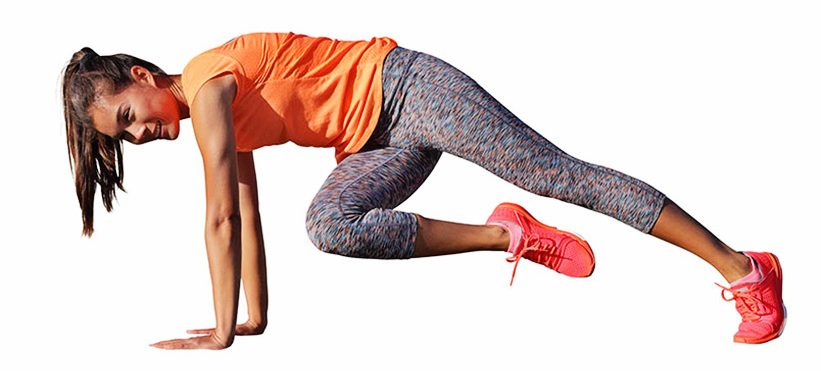
| Equipment | No equipment |
| Frequency | 3-4 days a week |
| Duration | 20 reps, 3 sets (10-15 minutes) |
| How to do it | Get into the plank position, your hands slightly wider than shoulder-width apart. Bring one of your knees up towards the elbow opposite to it and alternate with the other knee. Continue quickly alternating until you complete one set. |
| Tips | Keep your core engage and your back, neck, and head aligned. Breath slowly and don’t rush the movements. |
3. Chest presses
The dumbbell chest press strengthens your chest muscles but also your shoulders and triceps. It also works to improve your posture because it engages the core and upper back. Begin with 2-5 pound weighs and increase to 5-8 pound weights after two to three weeks of regular chest presses.
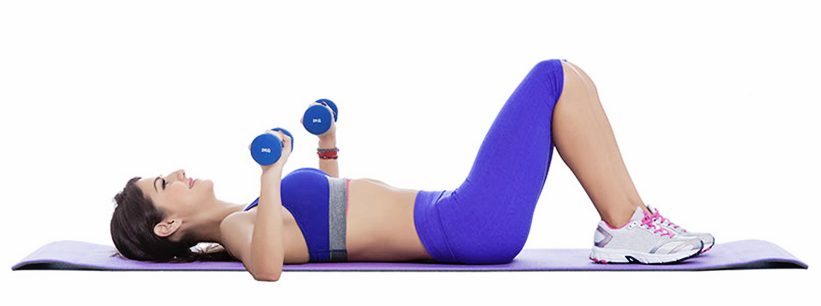
| Equipment | Dumbbells |
| Frequency | 3-4 days a week |
| Duration | 20 reps, 3 sets (10-20 minutes) |
| How to do it | Lie down with knees slightly bent and a dumbbell in each hand. Lift the dumbbells towards the ceiling. Your arms should be straight up from your shoulders. Lower your arms so they’re at a 90-degree angle and repeat. |
| Tips | Keep your spine in a neutral position and breath out as you’re lifting the dumbbells. |
4. Burpees
Also known as squat thrusts, burpees are an intense and dynamic full-body exercise that is used both as strength training and as an aerobic workout. It increases heart and breathing rate, boosts strength and agility, and improved flexibility. It engages all major muscle groups and burns a lot of calories in a short period of time.

| Equipment | No equipment |
| Frequency | 5-7 days a week |
| Duration | 15-20 reps, 2 sets (15-20 minutes) |
| How to do it | Start by standing straight, feet slightly apart. Move into a squatting position with hands on the ground. Kick feet back to get into a plank position while keeping hands on the ground. Return feet into squatting position and jump back up into a standing position. |
| Tips | If you want to use burpees for cardio, do up to 5 sets of up to 15 burpees. |
5. Cross crunches
If you want to work on your abs and obliques, then this workout will do both. This workout can be done by beginners, but if you increase its intensity, it can make for a great intermediate workout. Besides toning your abdominal region, cross crunches help support a healthy posture.

| Equipment | No equipment |
| Frequency | 5-7 days a week |
| Duration | 50 reps, 2 sets (20-30 minutes) |
| How to do it | Begin by lying on your back with your knees bent. Crunch and lift your left elbow towards your right knee, then alternate with the other side. Engage your abdominal muscles while doing so. |
| Tips | Avoid yanking your neck when doing cross crunches or doing them too fast. You want each movement to be careful and deliberate. |
Advanced at Home Workout
1. Stability ball press
Make good use of your stability ball by performing this chest press workout at least once a week. It’s mostly chest muscle exercise but that also helps enhance stability and engages the triceps, shoulders, and core muscles.
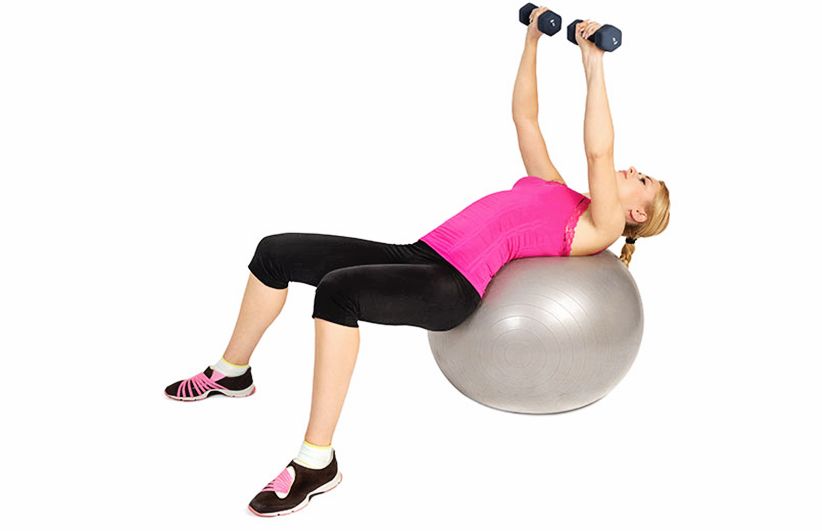
| Equipment | Dumbbells and stability ball |
| Frequency | 1-3 days a week |
| Duration | 20-30 reps, 2 sets (20 minutes) |
| How to do it | Carefully sit on a stability ball while holding a pair of dumbbells. Slide down the ball so you’re lying with the middle of your upper back on it, with knees bent and your lower body supported on your feet. Push dumbbells upwards, extending your arms so they’re straight over your shoulders. Lower your arms down and towards your sides and repeat. |
| Tips | Make sure your head and spine are in a neutral position. Tighten your core and breath out as you lift the dumbbells. |
2. Boat twist
Another exercise that works the abs and obliques, the boat twist is also great for strengthening your lower back for a healthier posture. This one will also push you beyond your limits if you’re just starting out with advanced workouts.
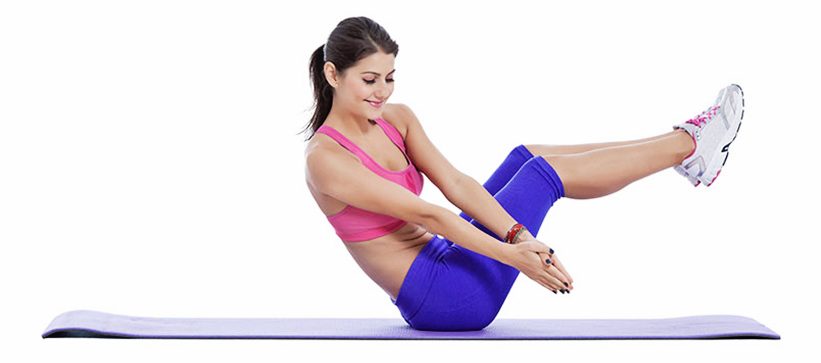
| Equipment | No equipment |
| Frequency | 1-3 days a week |
| Duration | 2-3 sets (40 minutes) |
| How to do it | Sit on the floor with your knees slightly bent. Extend your arms in front of you and clasp your palms together. Lift your feet from the ground supporting your body on your buttocks. Move your clasped arms tone one side while twisting your torso and repeat on the other side. |
| Tips | If you have problems with the lower back, skip this exercise. If not, make sure to breath out as you twist to one side and to twist beginning at your lower ribs. |
3. Superman’s exercise
This workout complements the boat twist perfectly. It engages your middle and lower back and also works your abdominal muscles. If you need to work on your core, definitely add this fat-burning exercise to your plan.

| Equipment | No equipment |
| Frequency | 1-3 days a week |
| Duration | 2-3 sets, 20 reps (15-20 minutes) |
| How to do it | Lie face down on the floor, arms extended in front of you and legs fully extended. Take a deep breath and lift arms and legs simultaneously, stretching your back. Hold for a couple of seconds breathing steadily, return to starting position, and repeat. |
| Tips | Keep your core muscles tight as you’re doing this workout. Make sure to not hold your breath the whole time you’re holding this pose. |
4. Mountain climber with band
This quick leg motion workout targets obliques, hamstrings, and glutes. Use a resistance band to make for an advanced workout that will help you burn more calories.
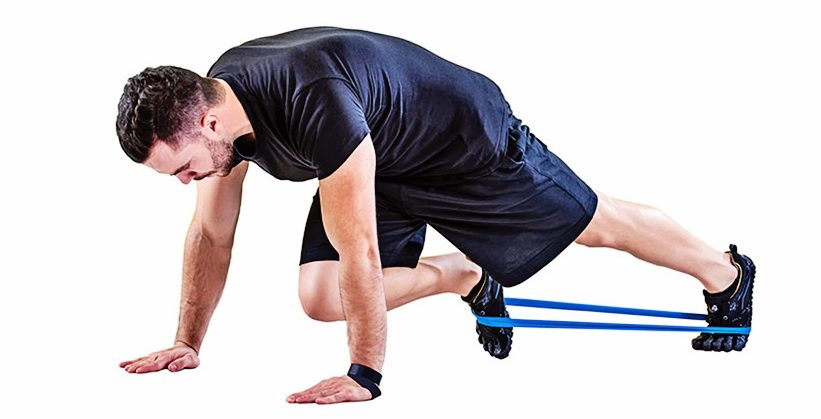
| Equipment | Resistance band |
| Frequency | 1-3 times a week |
| Duration | 20 reps, 3 sets (20-25 minutes) |
| How to do it | Loop a resistance band around both feet and start in plank position, supporting your upper body on fully extended arms. Bring right knee toward your chest while keeping your other foot flat on the floor. Alternate between legs and rest 20 seconds after you complete one minute of this. |
| Tips | Make sure you’re looking down while your neck is in neutral position. It’s ok if your back is slightly hunched during this workout but do try to keep it in neutral position if you can manage. |
5. Triceps Dips
If you want to have toned arms, then triceps dips are a must at-home workout. Besides working the triceps muscles, this exercise also engages the core and chest.
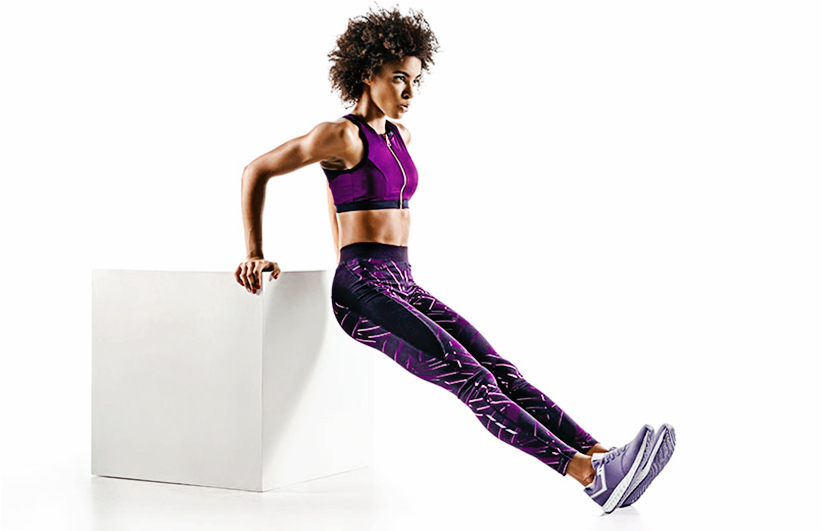
| Equipment | Bench or chair |
| Frequency | 5 times per week |
| Duration | 2 sets, 30 reps (20 minutes) |
| How to do it | Stand in front of a chair or bench. Place your hands behind you on the chair or bench. Extend your legs in front of you and bend your elbows. Lower your body in front of the chair/bench. |
| Tips | Make sure the surface you’re using to support your weight heavy and doesn’t move easily. That way you’ll avoid falls. |
Conclusion
These 15 workouts can help you on your weight-loss journey by boosting your aerobic fitness and muscle strength. With greater muscle strength, you may also increase your REE, which is an important determining factor when it comes to weight loss.
Of course, these workouts will only work when combined with a ketogenic, or other weight-loss diet plan. Make sure that you’re eating fewer calories than you are burning and allow yourself to recover in-between workouts. Often at times, an increase in exercise can increase calorie needs. A ketogenic diet will help to reduce hunger pains, so that you can stay in a calorie deficit.
Takeaways
- A variety of exercises will help you lose weight faster. Try a combination of cardio, resistance training, and interval training.
- At-home workouts are the perfect solution for those who can’t or prefer not to go to the gym.
- Completing at least 150 minutes of aerobic activity each week promotes good health.
- If you want to achieve weight loss, aim for more than 150 minutes per week.
- The ketogenic diet won’t cause a drop in REE (resting energy expenditure) and will boost fat metabolism.



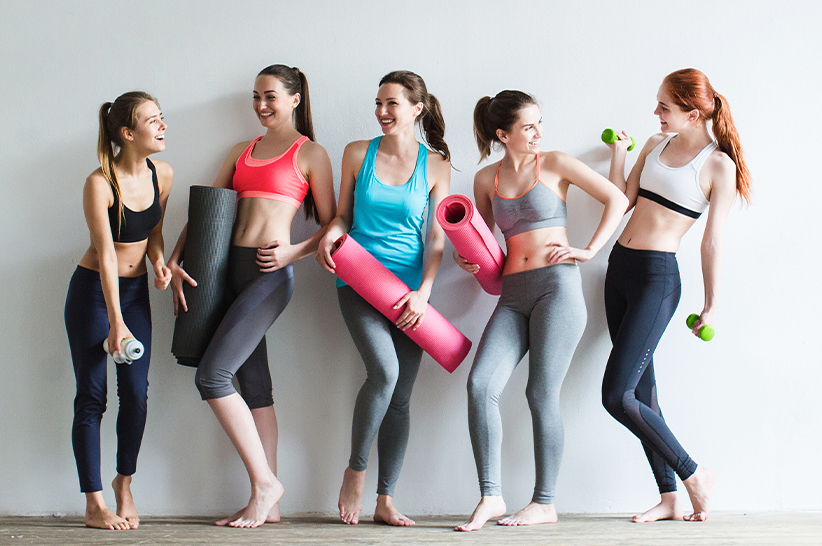
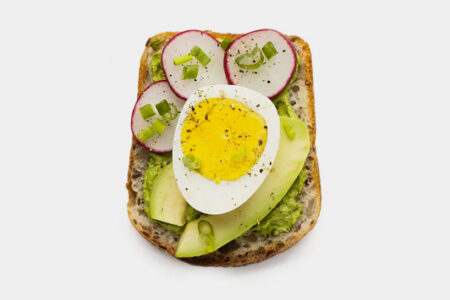
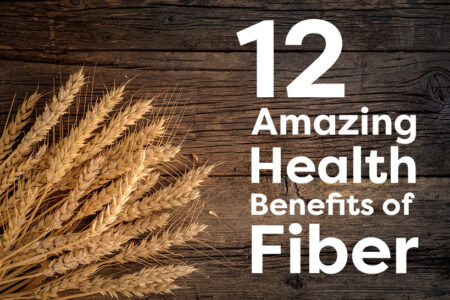




![Juicing for Weight Loss: Everything You Need to Know [Plus Recipes]](/wp-content/uploads/2019/08/Juicing-for-Weight-featured-image.jpg)

